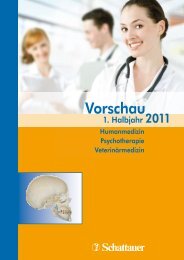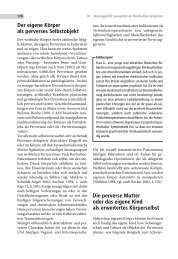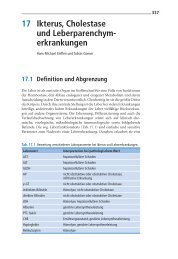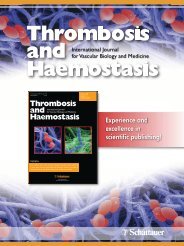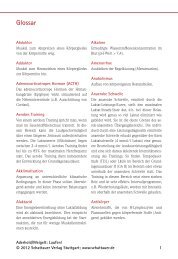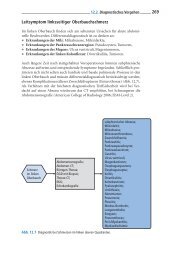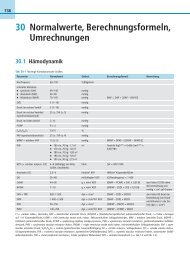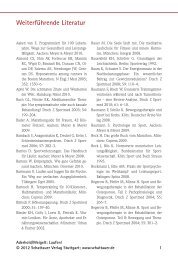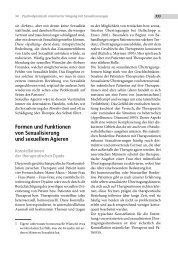DVO Guideline 2009 for Prevention, Diagnosis and Therapy of ...
DVO Guideline 2009 for Prevention, Diagnosis and Therapy of ...
DVO Guideline 2009 for Prevention, Diagnosis and Therapy of ...
Create successful ePaper yourself
Turn your PDF publications into a flip-book with our unique Google optimized e-Paper software.
72 <strong>DVO</strong> <strong>Guideline</strong> Osteoporosis <strong>2009</strong><br />
<strong>and</strong> metamizole are alternatives with a<br />
lower side effect potential (D).<br />
Opiates have only low organ toxicity but<br />
cannot be used in many cases due to sometimes<br />
having serious side effects <strong>and</strong> intolerances<br />
(e. g. nausea, dizziness, obstipation).<br />
There are no high-quality trials on<br />
the efficacy <strong>for</strong> patients with osteoporosis<br />
(D). Opiates are also associated with an increased<br />
fall rate (A).<br />
Parenterally applied calcitonin has an<br />
analgesic effect in the case <strong>of</strong> acute fractures<br />
(B). The efficacy is similar to other analgesics.<br />
Due to higher costs <strong>and</strong> a higher<br />
level <strong>of</strong> side effects use <strong>of</strong> calcitonin as a<br />
pain therapy is not recommended. For<br />
nasal application an analgesic effect has not<br />
yet been proved.<br />
An (low) analgesic effect <strong>of</strong> bisphosphonates<br />
after vertebral fractures has been<br />
shown <strong>for</strong> intravenous high dosage therapy<br />
but not <strong>for</strong> the doses normally applied in<br />
osteoporosis treatment (B) (E166).<br />
For bisphosphonate dosages typical <strong>of</strong><br />
osteoporosis <strong>and</strong> <strong>for</strong> other fracture reducing<br />
osteoporosis therapeutics a reduced<br />
long-term incidence <strong>of</strong> back pain is proved<br />
(A), probably due to the reduction in new<br />
vertebral fractures (D).<br />
A close monitoring <strong>of</strong> analgesic drug<br />
treatment <strong>and</strong> a limitation to short periods<br />
<strong>of</strong> time is recommended (D). If applicable<br />
an orthosis which erects the spine should<br />
be provided (D). In case <strong>of</strong> problems such<br />
as pain <strong>and</strong> functional limitations which<br />
cannot be solved <strong>for</strong> outpatients despite<br />
using all conservative measures, hospital<br />
admission might become necessary (D).<br />
10.5.2 Rehabilitation<br />
The options <strong>for</strong> inpatient or outpatient rehabilitation<br />
should be assessed (A <strong>for</strong> hip<br />
fractures, D <strong>for</strong> other acute osteoporotic<br />
fractures or chronic pain syndromes).<br />
10.5.3 Kyphoplasty <strong>and</strong><br />
Vertebroplasty<br />
Open observation studies <strong>and</strong> r<strong>and</strong>omised<br />
unblinded studies showed a clinical relevant<br />
additional pain reducing effect <strong>of</strong><br />
kyphoplasty <strong>and</strong> vertebroplasty on patients<br />
with newer vertebral fractures <strong>for</strong> whom a<br />
conservative pain treatment alone was not<br />
sufficient (C). Two r<strong>and</strong>omised controlled<br />
blinded studies on vertebroplasty, however,<br />
did not show any advantages (E 186), i. e.<br />
the pain reducing effect <strong>of</strong> a sham surgery<br />
was similar compared to that <strong>of</strong> a vertebroplasty<br />
(B). R<strong>and</strong>omised, blinded trials <strong>for</strong><br />
kyphoplasty do not exist at present. Metaanalyses<br />
<strong>of</strong> nonr<strong>and</strong>omised comparison<br />
studies <strong>and</strong> one r<strong>and</strong>omised unblinded<br />
comparison study between kyphoplasty<br />
<strong>and</strong> vertebroplasty however do not show<br />
any difference in the analgesic effect <strong>of</strong> both<br />
methods (B), thus an analgesic effect <strong>of</strong> a<br />
kyphoplasty superior to that <strong>of</strong> a sham surgery<br />
is doubtful (E186). Furthermore, it has<br />
to be taken into consideration that longterm<br />
experiences with regard to risks <strong>and</strong><br />
benefits <strong>of</strong> these procedures are not yet<br />
available. Whether possible changes in the<br />
biomechanics have a clinical relevance is<br />
presently not proved <strong>and</strong> has to be evaluated<br />
in prospective long-term studies. Data<br />
are especially inconsistent with regard to an<br />
increased fracture rate after kyphoplasty/<br />
vertebroplasty (C) (E158–E170). As both<br />
methods might have complications, <strong>and</strong> as<br />
the indication as well as the effect size remains<br />
uncertain in the individual case,<br />
centres which use these procedures should<br />
only consider them<br />
1. after a documented conservative treatment<br />
attempt over 3 weeks,<br />
2. after exclusion <strong>of</strong> degenerative changes<br />
<strong>of</strong> the spine as the reason <strong>for</strong> the complaints<br />
<strong>and</strong><br />
3. after documented interdisciplinary individual<br />
case review discussion.<br />
10.5.4 Chronic Pain after Vertebral<br />
Fractures<br />
Physiotherapeutic measures <strong>for</strong> pain reduction<br />
<strong>and</strong> to enable mobilisation should<br />
accompany a pharmacological pain treatment<br />
(D). Occupational therapy may support<br />
this aim by practising pain reducing<br />
strategies in every-day life as well as by<br />
adapting the physical surroundings to facilitate<br />
independent activity <strong>and</strong> to help<br />
prevent falls (D). An interference current<br />
therapy has proved to be pain reducing in<br />
the case <strong>of</strong> therapy <strong>of</strong> chronic back pain<br />
after vertebral fractures (E167) (B). Where<br />
appropriate, a spine erecting orthesis<br />
should be used (B).<br />
The overall health status significantly<br />
determines the existence <strong>and</strong> the consequences<br />
<strong>of</strong> back pain in old age. There<strong>for</strong>e,<br />
it is important to include biopsychosocial<br />
factors (e. g. depression) in the treatment<br />
concept <strong>of</strong> back pain in old age (C)<br />
(E165).<br />
11. Monitoring, Treatment<br />
Duration<br />
11.1 Follow-up <strong>for</strong> Patients<br />
without Drug Treatment<br />
Patients with a moderately increased risk<br />
in the initial examination (i. e. a T-score<br />
< 1.0 <strong>and</strong>/or fractures <strong>and</strong>/or risk <strong>of</strong> falls<br />
<strong>and</strong>/or glucocorticoids > 3 months) below<br />
a 10-year fracture risk <strong>of</strong> 30 %, should be<br />
reassessed with regard to the risk factors<br />
given in chapter 7 at intervals which are appropriate<br />
to the individual risk. The aims <strong>of</strong><br />
these follow-ups are the continuous determination<br />
<strong>of</strong> the fracture-risk pr<strong>of</strong>ile <strong>and</strong><br />
the compliance with the treatment aims.<br />
The intervals can be determined individually<br />
depending on the risk in question <strong>and</strong><br />
the treatment consequences to be expected<br />
(D) (E173).<br />
A detailed re-evaluation assessing pain,<br />
functional status, risk factors, implementation<br />
<strong>of</strong> nonpharmacological measures,<br />
weight <strong>and</strong> height should be carried out<br />
after 2 years. In the case <strong>of</strong> glucocorticoid<br />
intake at higher doses (≥ 7.5 mg/day <strong>for</strong><br />
more than 1 year) it should already be<br />
undertaken after 6–12 months (D).<br />
As a reduction in bone density exceeding<br />
the least significant chance <strong>of</strong> measurement<br />
is rare be<strong>for</strong>e a period <strong>of</strong> 2 years, follow-up<br />
examinations are in general not<br />
recommended be<strong>for</strong>e a treatment period <strong>of</strong><br />
2 to 5 years <strong>and</strong> should be adapted to the<br />
risk pr<strong>of</strong>ile (B). The relative intervals are to<br />
be determined depending on newly developed<br />
risk factors <strong>and</strong> initial bone mineral<br />
density. In the case <strong>of</strong> a high dosage glucocorticoid<br />
treatment, especially if treatment<br />
was just initiated or is at treatment start,<br />
then shorter intervals <strong>of</strong> 1 year or in individual<br />
cases even 6 months might be reasonable.<br />
A decrease in bone mineral density <strong>of</strong><br />
more than 5 % at the total hip in the<br />
Osteologie 1/2011 © Schattauer 2011



